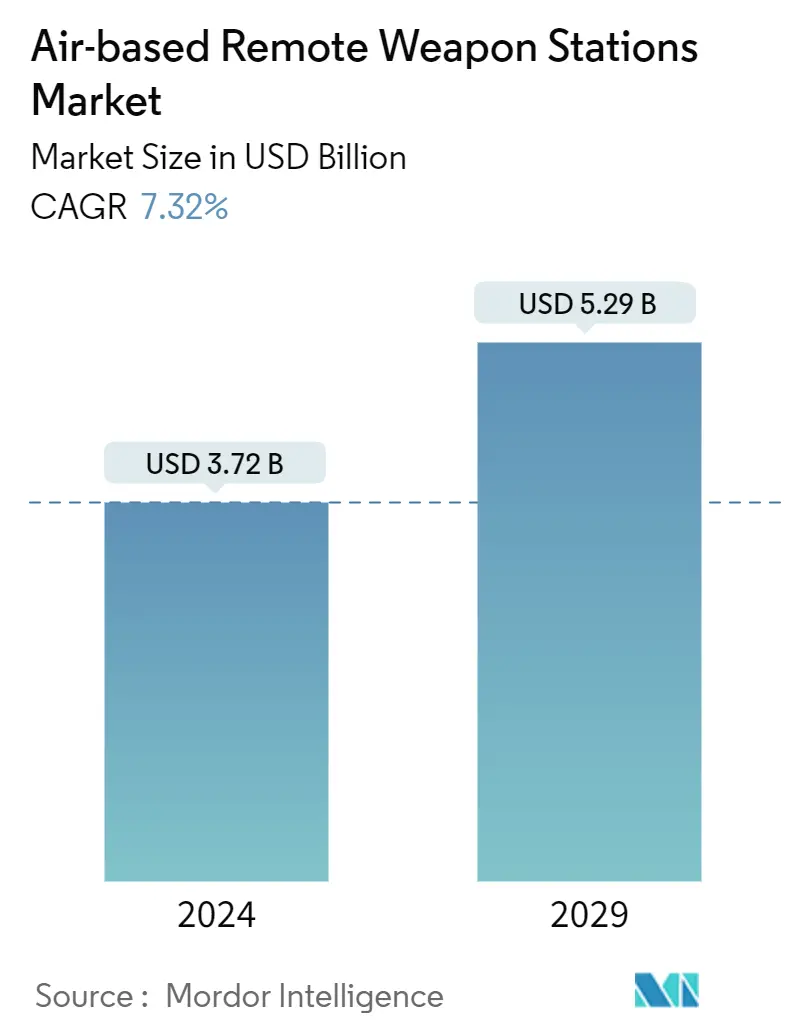Market Size of Air-based Remote Weapon Stations Industry

| Study Period | 2019 - 2029 |
| Market Size (2024) | USD 3.72 Billion |
| Market Size (2029) | USD 5.29 Billion |
| CAGR (2024 - 2029) | 7.32 % |
| Fastest Growing Market | North America |
| Largest Market | North America |
| Market Concentration | High |
Major Players
*Disclaimer: Major Players sorted in no particular order |
Air-based Remote Weapon Stations Market Analysis
The Air-based Remote Weapon Stations Market size is estimated at USD 3.72 billion in 2024, and is expected to reach USD 5.29 billion by 2029, growing at a CAGR of 7.32% during the forecast period (2024-2029).
New technologies and platforms have transformed the warfare strategies of nations such as the United States, Russia, and China. These countries have diverted their efforts toward developing sophisticated and powerful weapons that can severely impact enemy strongholds and help attain a tactical advantage in case of an armed standoff. RWS is used extensively in current warfare scenarios due to its visual superiority and capability to perform pre-emptive strikes on specific locations. The increasing investments of armed forces and remote weapon systems manufacturers into developing advanced remote weapon stations integrated with new sensor technologies (visual systems) and firing systems (like directed energy weapons) are anticipated to bolster the market's growth in the coming years.
However, the market may be deterred by the design challenges system integrators face to incorporate advanced features in their product portfolio without compromising the payload capacity, aerodynamic profile, and range of a delivery platform. Designers must also ensure the availability of sophisticated integrated features cross-compatibility with the advanced optronic sensors and subsystems from other system manufacturers to develop a fully operational RWS, rendering a complex outlook to the overall system design.
Air-based Remote Weapon Stations Industry Segmentation
An air-based remote weapon station is a remotely operated weaponized system with firing and related control systems for light and medium-caliber weapons on aerial platforms.
The air-based remote weapon station market is segmented by component, platform, and geography. By component, the market is segmented into weaponry and vision systems. By platform, the market is segmented into aircraft, helicopters, and unmanned aerial vehicles. The report also covers the market sizes and forecasts for the air-based remote weapon stations market in major countries across different regions. For each segment, the market size is provided in terms of value (USD).
| Component | |
| Weaponry | |
| Vision Systems |
| Platform | |
| Aircraft | |
| Helicopters | |
| Unmanned Aerial Vehicles |
| Geography | |||||||
| |||||||
| |||||||
| |||||||
| Rest of the World |
Air-based Remote Weapon Stations Market Size Summary
The air-based remote weapon stations market is poised for significant growth, driven by advancements in military technology and strategic shifts in warfare tactics by major global powers such as the United States, Russia, and China. These nations are increasingly investing in sophisticated weapon systems that offer visual superiority and the ability to conduct pre-emptive strikes, thereby gaining a tactical edge in potential conflicts. The market is expected to expand as armed forces and manufacturers focus on integrating advanced sensor and firing technologies, including directed energy weapons, into remote weapon stations. However, challenges remain in system design, particularly in maintaining payload capacity and aerodynamic efficiency while incorporating these advanced features. The complexity of ensuring cross-compatibility with optronic sensors and subsystems from various manufacturers adds to the intricate nature of developing fully operational remote weapon systems.
In North America, the market is further bolstered by increased defense budgets and modernization programs aimed at enhancing the capabilities of combat aircraft, helicopters, and uncrewed aerial vehicles. The United States, a leading user and exporter of these systems, is actively upgrading its arsenal to counter threats from adversaries like Russia and China. This includes integrating advanced weapon systems into existing platforms, such as the F-35 Joint Strike Fighter. The market is characterized by a few dominant players, including Elbit Systems Ltd, Rafael Advanced Defense Systems Ltd, Leonardo S.p.A, General Dynamics Corporation, and BAE Systems plc, who are investing in expanding their product portfolios and entering strategic collaborations. These efforts are expected to enhance their presence in emerging markets and meet the evolving demands of defense forces worldwide.
Air-based Remote Weapon Stations Market Size - Table of Contents
-
1. MARKET DYNAMICS
-
1.1 Market Overview
-
1.2 Market Drivers
-
1.3 Market Restraints
-
1.4 Porter's Five Forces Analysis
-
1.4.1 Bargaining Power of Suppliers
-
1.4.2 Bargaining Power of Buyers/Consumers
-
1.4.3 Threat of New Entrants
-
1.4.4 Threat of Substitute Products
-
1.4.5 Intensity of Competitive Rivalry
-
-
-
2. MARKET SEGMENTATION
-
2.1 Component
-
2.1.1 Weaponry
-
2.1.2 Vision Systems
-
-
2.2 Platform
-
2.2.1 Aircraft
-
2.2.2 Helicopters
-
2.2.3 Unmanned Aerial Vehicles
-
-
2.3 Geography
-
2.3.1 North America
-
2.3.1.1 United States
-
2.3.1.2 Canada
-
-
2.3.2 Europe
-
2.3.2.1 United Kingdom
-
2.3.2.2 France
-
2.3.2.3 Germany
-
2.3.2.4 Russia
-
2.3.2.5 Rest of Europe
-
-
2.3.3 Asia-Pacific
-
2.3.3.1 China
-
2.3.3.2 India
-
2.3.3.3 Japan
-
2.3.3.4 South Korea
-
2.3.3.5 Rest of Asia-Pacific
-
-
2.3.4 Rest of the World
-
-
Air-based Remote Weapon Stations Market Size FAQs
How big is the Air-based Remote Weapon Stations Market?
The Air-based Remote Weapon Stations Market size is expected to reach USD 3.99 billion in 2025 and grow at a CAGR of 7.32% to reach USD 5.68 billion by 2030.
What is the current Air-based Remote Weapon Stations Market size?
In 2025, the Air-based Remote Weapon Stations Market size is expected to reach USD 3.99 billion.

